Roz Savage's Blog, page 24
March 29, 2018
Whose are your Hoops?
Yesterday I was giving a talk at Newlands Girls School, plus a minibus-ful of boys from nearly Desborough College, so we had over 100 students in the room, aged 16 to 18.
At the risk of incurring the wrath of the teachers in the room, I cautioned the students against getting addicted to exam success, and the resulting pats on the back from parents and teachers. Of course, I added hastily, passing exams is good. But be careful about choosing your path through life by jumping through other people’s hoops. Make sure that they are the hoops that you actually want to jump through, and not just the ones that earn approval. Feel free to create your own hoops.
As someone who was myself addicted to other people’s hoops until my early thirties, I’ve thought about this a lot. We have a deep psychological need for approval and inclusion, which can lead to conformity, and conformity can be dangerous.
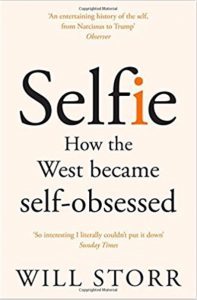 To back up my position on this, I’m going to call on Will Storr, who I mentioned last week – the author of Selfie: How The West Became Self-Obsessed (reviewed here).
To back up my position on this, I’m going to call on Will Storr, who I mentioned last week – the author of Selfie: How The West Became Self-Obsessed (reviewed here).
In his wide-ranging book, he posits that our brains are constantly assessing:
Who do I need to be in order to get along and get ahead in this environment?
So our “self” is inextricable from our culture, as each culture has its own unique ecosystem of incentives, norms, and taboos. As early as the age of 14 months, we are looking around to see who seems to be thriving in our in-group, and we copy them. This behaviour is automatic and subconscious, so our culture permeates us in ways we’re not even aware of.
One of the fastest ways that culture can change is when powerful people change the incentives. When a new kind of behaviour is being rewarded, we see a different kind of person thriving, and our brain tells us that this is what we now need to do to get along and get ahead, and so we change our internal programming to conform to the new reality.
While this tendency is understandable, it may not be for the greater good.
 Ayn Rand
Ayn RandHere is an example, again from Selfie. Ayn Rand was a writer, a Russian emigrée who became very influential in the US. Her best-selling novel, Atlas Shrugged, described a society in which no one paid tax, everybody competed with everyone else and the markets were unhindered by regulation. Personal freedom was cherished above all, and if the people were to be free, so, too, must be their markets.
One of her disciples was the young Alan Greenspan. “What she did,” he said, “was to make me see that capitalism is not only efficient and practical, but also moral.” In 1987, Greenspan was appointed the Chairman of the Federal Reserve, probably the single most powerful figure affecting the global economy, and remained in this role for nearly 30 years. And his ideas spread around the world.
Business and banking were deregulated, utilities like telecoms, water, electricity and gas were denationalised and sold off. In the UK, council houses were sold into private ownership, arts funding was cut, social security for the jobless was restricted to “gift them the motivation” to get on their bike and get a job. Meanwhile, taxes at higher levels of income were cut, to reward the entrepreneurs and industrialists for their money-making skills and enable them to raise the stakes in this new and popular game of neoliberal economics.
As Storr writes: “The dream would be of a single competitive world market with no barriers to trade or controls on financial flows. The World Bank and the IMF would assist in this mission by offering desperately needed loans to developing nations on the condition they introduced neoliberal reforms… Increasingly, the state was not there to look after you any more, protecting your income, respecting your union, catching your fall. To get along and get ahead, in this competitive age, you had to be fit, ambitious, ruthless, relentless.”
 Alan Greenspan
Alan GreenspanAnd now we know how that ended. In 1999, Clinton repealed the laws that had been brought in to control the banks following the Wall Street Crash of 1929. This wave of deregulation brought into being the highly unstable derivatives market that was made up, in the words of Warren Buffett, of “financial weapons of mass destruction”. At the same time, the low interest rates (another of Greenspan’s preoccupations) enabled millions of cash-strapped people to take on irresponsible levels of mortgage debt, which led to the catastrophe of 2008.
As a result of the crash, in the US alone, more than 9 million homes were lost and almost 9 million jobs disappeared. In the UK, 3.7 million people lost their jobs – one in seven of all employees. Researchers concluded that, in the UK, between 2008 and 2010, there were around a thousand extra suicides, nearly 90 per cent of them male, because of the crash and the period of austerity that followed.
 And even apart from the human suffering, our natural world is also suffering. Our current economic system is all about maximising profits, which incentivises a company to – wherever possible – get its inputs by exploiting natural capital, and dispose of its outputs by dumping them into our air, sea, or soil. If the environmental cost of exploitation and pollution is not reflected in the economic cost, the company has no incentive to do otherwise.
And even apart from the human suffering, our natural world is also suffering. Our current economic system is all about maximising profits, which incentivises a company to – wherever possible – get its inputs by exploiting natural capital, and dispose of its outputs by dumping them into our air, sea, or soil. If the environmental cost of exploitation and pollution is not reflected in the economic cost, the company has no incentive to do otherwise.
Incentives are powerful. The behaviour that gets rewarded, gets reinforced and replicated. And it is precisely because incentives are powerful that we need to treat them with due caution and suspicion. Just because the culture in which we live rewards us for being a certain way and doing certain things doesn’t mean that this behaviour is right – either for us and/or for our society.
There is an important distinction between individualism and being an individual.
To me, individualism means believing in the supremacy of the self, entitlement, and selfishness. Paradoxically, the point of reference is external: the individualist wants to impress, to be seen to be getting ahead, to be the object of envy, to have more toys than the other kids in the sandpit. So they play by the rules of the current economic model in order to maximise their financial returns.
Being an individual, by contrast, means that the point of reference is internal. People look to their own hearts and consciences to figure out what ignites their passion and makes their soul sing. When people are happy – and nothing makes us happier than working on projects that are meaningful to us – research shows we are smarter, more altruistic, more generous and compassionate. Individuals are less susceptible to the current societal norms, risking censure and maybe even scorn if they don’t conform. It takes courage to tread this path, but we need more people – of all ages – to avoid the allure of approval.
We need more people to think for themselves and create their own hoops.
Other Stuff:
I had a wonderful time on SuperShe Island in Finland last weekend. Watch out for the article in Norwegian Air’s inflight magazine in May.
I’m planning to be at the Energy Disruptors conference this May, in Calgary, Canada. Let me know if you’re planning to be there!
Next week, a bit of a break. I’ll be taking a week’s holiday with my dear old Mum, heading to the Isle of Arran in Scotland. Hoping we don’t run into too much snow – it has been a crazy winter here in the UK.
And still lots happening with The Sisters, the global women’s network I am setting up and intending to launch in September this year. It’s quite different from anything I’ve done before – but hey, how hard can it be?!
March 22, 2018
Say No to Distraction, Yes to Action
If you have 3 minutes to spare, please watch this cute but cutting video about our mobile phone addiction. (And if you don’t think you have 3 minutes to spare, why not put your phone in flight mode for the rest of the day – the average person spends 90 minutes a day on their phone, so that should free up a good chunk of time.)
The video might exaggerate our addiction issue, but not much. You think it’s unlikely that a crowd would watch a young girl jump to her death from a high building, using their smartphones to video her from the ledge to the ground before carrying right on with their day? Check out these stories:
Shoppers take photos instead of trying to help a woman who has just been knocked down by a car ploughing through the door of a drugstore.
In Singapore, people were more interested in taking photos of a man whose leg was pinned underneath a bus than in helping to free him.
In County Durham, bystanders took photos rather than helping a mother and daughter who were trapped in their car when a tree fell onto it.
In Pittsburgh, people took selfies instead of helping a woman beaten unconscious in the street.

We hear a lot about the side-effects of mobile phone addiction – not just in situations like the above, but also on road safety, on relationships, memory, brain capacity, sleep, stress, and productivity – but I’m more interested in the flipside of that addiction: what is the opportunity cost of all that time we spent glued to our phones? Or to put it another way, what did we used to do with those 90 minutes that we don’t do now?
There are worrying signs that children are reading less in favour of social media, YouTube, and playing mobile games and apps. Reading is good for children, helping them develop language, literacy, curiosity, imagination, meaning-making and brain development. Online activities, not so much.
We used to spend more time getting to know people. In this Radio 4 programme, Hussein Chalayan, a fashion designer, mentions that in the past he used to get to know his models, and to build real relationships with them as people. Now, he says, the models are very young and they’re always on their phones, so he really doesn’t get to know them.
But in my view, even more worrying that not taking time to get to know other people, is that we miss out on time to get to know ourselves. Let me explain where I’m coming from with this.
I’m continuing to study the Gene Keys. According to my profile, my Life’s Work is the 10th Gene Key, “Being”. As with all the Gene Keys, Being has three levels:
Shadow (in the Jungian sense): Self-Obsession
Gift: Naturalness
With Being itself being the Divine Gift, or the highest form of this Gene Key.
An interesting feature of Being is that you have to go through the shadow of self-obsession before you can reach the gift of naturalness. The book explains that when we start to individuate (i.e. ask ourselves “Who am I?”), we have to go through the self-obsession phase in order to find that, when we peel away all the layers of the onion, there is nothing/everything there at the core. In other words, the further we go in seeking our “self”, the clearer it becomes that we have no self at all. This is the only way to make the journey. There is no shortcut directly to Naturalness without going via Self-Obsession.
This really resonated with me, as it very much describes my experience on the Atlantic Ocean. I had hoped to have entertainment, and was looking forward to listening to music on the onboard stereo. But for the first month the weather was too overcast for my solar panels to generate enough electricity for anything other than the absolute essentials (watermaker, GPS, satellite phone), and about two days after the sun came out, the stereo stopped working. I opened it up to find out the insides were rusted.
So I was left alone with no entertainment but my own thoughts. For three and a half months. Brutal.
It was no fun at the time, but wow, I seriously fast-tracked through the shadow of self-obsession (although I still have my moments!) and emerged into naturalness.
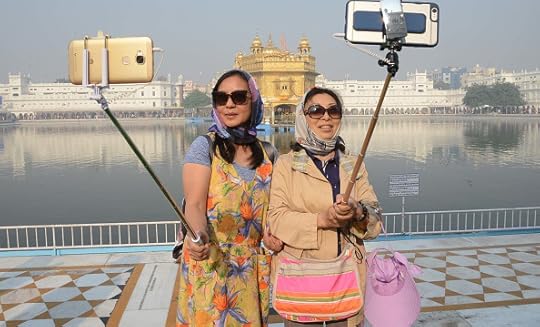 So the way I see it, the danger of our mobile phones is twofold (excluding the obvious physical danger of driving or walking into something):
So the way I see it, the danger of our mobile phones is twofold (excluding the obvious physical danger of driving or walking into something):
Often we’re using our phones for social media, which in itself promotes an unhealthy kind of self-obsession (I’m currently reading Selfie, by Will Storr, which draws disturbing conclusions about social media and suicide. And don’t even start me on the perils of Facebook.)
By not allowing our brains any down-time, we’re actually running away from ourselves. Rather than allow time for healthy reflection and introspection, we distract ourselves with mostly irrelevant trivia.
I can very much understand the temptation. This is not an easy world to fully engage with. Daily we are assaulted with crowds, noise, advertising, and terrifying stories about a globe gone haywire (like the death of the last male northern white rhino, or the collapse of France’s bird population). It’s not surprising that we seek solace in the reassuring glow of our mobile phone screen.
But that is not real life. That is not real living. More than ever, we need to be paying attention to reality, because it’s about to come and kick us in the backside.
Say no to distraction, and yes to engagement and action.
Other Stuff:
I’ve overdosed on speaker events this week:
Monday: Yuval Noah Harari and Thomas Friedman for How To Academy/New York Times – two brilliant minds debating pessimism vs optimism for the future
Tuesday: Adam Kay (doctor turned comedy writer, with some extremely wince-worthy anecdotes), Oliver Kamm (journalist), Mona Arshi (human rights lawyer turned poet), Tara Westover (daughter of radical survivalist Mormon parents), Wade Davis (more about him in a moment) and my friend Guin Batten (Olympian and ocean rower) for 5×15
Wednesday: Wade Davis (again) for How To Academy: anthropologist, ethnobotanist, National Geographic Explorer in Residence – fabulous slideshow and fascinating insights into the need for cultural diversity
All very well worth going to, but I’ll take a break for a while now.
Tomorrow I’m off to Finland for the weekend, to test run a new women-only retreat, occupying an entire island just west of Helsinki. We’re told the showers aren’t working yet, but worse things happen at sea. Looking forward to it!
March 15, 2018
Quantum Leap
Some days I’m an optimist, some days not so much. On the optimistic days I believe I can sense a real shift in the global mindset. And on the not-so-much days I wonder if my optimism is delusional, and existential despair threatens to overwhelm me.
The opening day of the World Ocean Summit was a not-so-much day. Ove Hoegh-Guldberg gave an excellent but very depressing presentation. When he said he wasn’t going to sugar-coat the truth, he wasn’t kidding. His cheery vision of the future includes:
 Ove Hoegh-Guldberg
Ove Hoegh-GuldbergOceans: increasing temperatures, increasing acidity, storms of increasing intensity, sea level rise, decreasing oxygen, dead zones, changing currents.
Fisheries: declining, extinction of species, unravelling ecosystems (coral, kelp), declining ocean productivity, coastal threats, mass shifts in species.
Failure to protect the oceans: potential loss of livelihood for 500 million people, loss of protein for 3 billion people, loss of 50% of the world’s oxygen production.
He muttered ominously about the “absence of precautionary principles” – and it was hard to disagree in the face of such daunting statistics. Sustainable Development Goal #14 and the Paris Agreement notwithstanding, the oceans are still in a world of trouble, which means trouble for the world. Looking at the inescapable logic of the IPAT equation (Impact = Population x Affluence x Technology) it would seem that we are doomed.

So, you might be wondering, how can I ever feel optimistic? Here’s how.
When you hear Carter and Olivia Ries talk about the animal conservation organisation they founded when aged 8 and 7 respectively, aptly named OMG (One More Generation), how can you NOT feel hopeful?
And more broadly, my perception, based on the undoubtedly very non-representative sample of people that pass through my orbit, I think there is a real shift going on. Humans tend to think in a linear fashion, assuming that the past is a good determinant of the future. But this is not so. We live in a tremendously complex system, where transformative change can happen very suddenly, and apparently without warning. A new direction can simmer away beneath the surface, like molten lava beneath the crust of the Earth, before erupting into a new paradigm.
Edward Lorenz defined chaos theory thus:
When the present determines the future, but the approximate present does not approximately determine the future.
Wikipedia expands on the theory:
Small differences in initial conditions… yield widely diverging outcomes for such dynamical systems, rendering long-term prediction of their behaviour impossible in general. This happens even though these systems are deterministic, meaning that their future behaviour is fully determined by their initial conditions, with no random elements involved. In other words, the deterministic nature of these systems does not make them predictable.
 Barbara Marx Hubbard
Barbara Marx HubbardBarbara Marx Hubbard describes it more poetically in her book, Conscious Evolution:
Let’s compare our situation with the metamorphosis of a caterpillar into a butterfly. When the caterpillar weaves its cocoon, imaginal discs begin to appear. These discs embody the blueprint of the butterfly yet to come. Although the discs are a natural part of the caterpillar’s evolution, its immune system recognizes them as foreign and tries to destroy them. As the discs arrive faster and begin to link up, the caterpillar’s immune system breaks down and its body begins to disintegrate. When the discs mature and become imaginal cells, they form themselves into a new pattern, thus transforming the disintegrating body of the caterpillar into the butterfly. The breakdown of the caterpillar’s old system is essential for the breakthrough of the new butterfly. Yet, in reality the caterpillar neither dies nor disintegrates, for from the beginning its hidden purpose was to transform and be reborn as the butterfly.
Once a caterpillar has disintegrated all of its tissues except for the imaginal discs, those discs use the protein-rich soup all around them to fuel the rapid cell division required to form the wings, antennae, legs, eyes, genitals and all the other features of an adult butterfly or moth. By applying this analogy, we can see that during the 1960s our social systems started to become dysfunctional, or began to “disintegrate,” as we experienced the Cold War and the threat to the environment, the growing population crisis, pollution, and social inequities. As people started waking up, they became imaginal discs in the body of society.
I’m honoured to personally know a significant and growing number of “imaginal discs”. It is these friends and colleagues that give me hope that, far from being doomed by our linear progression towards catastrophe, we are on the verge of a quantum leap into a better way of being, and a higher level of consciousness.
If I can do anything to help nudge humanity towards the tipping point and that quantum leap, then I can imagine nothing more fulfilling to do with my time. And if all my efforts are in vain, either because we fail as a species or because the shift was going to happen anyway, then I will carry on doing what I can regardless, again because I can imagine nothing more fulfilling to do with my time.
So, in the desperate horse race between Enlightenment and Extinction, I’m putting my money on Enlightenment. I hope you will join me.
Other Stuff:
In keeping with the above, I loved this quote from Shakespeare’s Julius Caesar, via the UN’s Special Envoy for the Oceans, Peter Thomson:
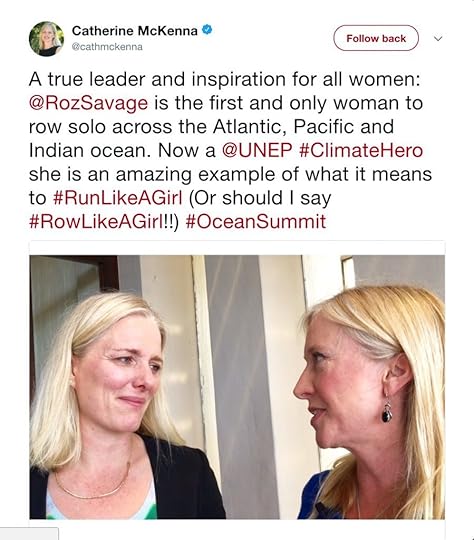
“There is a tide in the affairs of men
Which, taken at the flood, leads on to fortune;
Omitted, all the voyage of their life
Is bound in shallows and in miseries.
On such a full sea are we now afloat;
And we must take the current when it serves,
Or lose our ventures.”
While I was at the World Ocean Summit I had an hour-long meeting with the Canadian Environment Minister, Catherine McKenna. We recorded a short video for International Women’s Day, but I haven’t been able to find it. Hey, but here’s a photo anyway!
Earlier this year I recorded this podcast with Martin Grunberg of The Habit Factor. He asked me some great questions that really got me thinking. I hope you enjoy it! An Ocean of Purpose
And another podcast, this one with Nicole Antoinette: Roz Savage on Courage, Change, and Rowing Solo Across Three Oceans
To help us clean up our act, here is some soap. Thanks to Dr Bronner’s for using their organic and fairtrade soap to inspire environmental action!

March 8, 2018
Thoughts from the World Ocean Summit
Today is the first day of the World Ocean Summit in Mexico, hosted by The Economist. Tomorrow is going to be a busy day, so I’m scheduling my blog post now to go live in the morning.
 So far, as you might expect, there has been a noticeable financial slant to many of the presentations. If, when you have a hammer, everything looks like a nail, then I suppose that when you are an economist, everything looks like an economic problem – with an economic solution. At the risk of being controversial, I’d like to suggest that it’s hard to solve a problem from within the same system that caused it in the first place. Conventional capitalism has made a poor governing principle, in that it has created financial incentives that run counter to the long term common good. I hope that the discussion will turn to deeper principles, with those principles becoming the master, and economics the servant.
So far, as you might expect, there has been a noticeable financial slant to many of the presentations. If, when you have a hammer, everything looks like a nail, then I suppose that when you are an economist, everything looks like an economic problem – with an economic solution. At the risk of being controversial, I’d like to suggest that it’s hard to solve a problem from within the same system that caused it in the first place. Conventional capitalism has made a poor governing principle, in that it has created financial incentives that run counter to the long term common good. I hope that the discussion will turn to deeper principles, with those principles becoming the master, and economics the servant.
Tomorrow night I’m speaking on a panel with scientist Susan Shaw and filmmaker Alexandra Cousteau. We were asked to prepare some thoughts in advance, so here is a sneak preview of my insights from around 520 days spent alone at sea.
It’s a Small World After All
One of the many reasons I wanted to row across the oceans was to get a real sense of the size of the world, in a way that we don’t when we fly. And I’m surprised how small it feels. Rowing at less than walking speed, I was able to row across a large proportion of the world’s circumference in just over 500 days. It amazes me that this small planet is able to support 7.5 billion people – although, as we know, we are already in overshoot, so this situation is clearly not sustainable.
 The Heart of the Monster
The Heart of the Monster
I sometimes think of our environmental challenges as being like a many-headed sea monster. We can keep cutting off the head of plastic pollution, climate change, deforestation, and so on, but the monster will just keep sprouting new heads until we get to the heart of the monster, which I believe is this story that we have that nature is ours to exploit and pollute as we see fit. We need to reawaken to the fact that we are part of nature, and when we damage that amazing and diverse web of life, we damage ourselves and our future prospects as a species. So we need to change that narrative, and heal our relationship with nature.
A New Definition of Success
Like many of us, I have days when it’s hard to be optimistic. But on the whole I am seeing real signs of a shift in consciousness. I am seeing more and more people choosing to live low impact lifestyles. I am seeing a cultural shift in how we define success, from a that old-school materialistic definition to a much more holistic kind of success. I am seeing new business models that are real game-changers, the emergence of a whole different kind of economics. And I’m seeing exciting new technologies that enable people around the world to connect and co-create a better future.
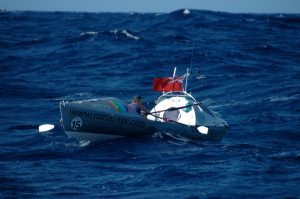 Humility instead of Hubris
Humility instead of Hubris
There is nothing like being alone at sea in a 23-foot rowboat to remind you where human beings stand in the overall scheme of things. Nature is incredibly powerful, and as we are being reminded by wildfires and floods and mudslides and earthquakes, even on dry land humans can be very vulnerable. The oceans taught me a huge respect for Mother Nature, and I believe it would be a good idea for more of us to treat her with the respect she deserves.
The theme of the conference is around the implementation and accountability of the Sustainable Development Goals and the Paris Agreement, so my spiritual/psychological approach may be the odd (wo)man out. But this is what I see, and I’m going to say it. Not much point rowing 15,000 miles if it hasn’t earned you the right to express an opinion on the future of the oceans!
Other Stuff:
Had a wonderful time at the launch of Not Doing (to which I contributed) last Thursday. Sadly Mac Macartney wasn’t able to make it due to the snow down in Devon, but overall there was a good turnout and a great conversation. Apparently Amazon has listed the title incorrectly – it should actually be Not Doing: The Art of Effortless Action. And I should have mentioned that Steven d’Souza co-authored it with Diana Renner. Apologies to Diana!
It’s great being back in Mexico. Last weekend I spent several days with the Together team that is developing the Noomap/Infinite World Game, who I first met last month. It looks likely that some of them will be in the UK very soon, so somehow the stars are aligning to enable us to spend a lot of time together and hatch plans to make the world a better place.
Thanks to the Together team, I’ve become fascinated by the Gene Keys. There’s an almost infinite amount of depth to it, and I’m just beginning, but it’s an intriguing system, and spookily accurate. If you’re interested, I suggest you get your free profile, and you’ll also definitely need a book or a course or an expert if you’re going to make any sense out of it, as it’s not self-explanatory.
Happy Mother’s Day to all the (non-US) mothers out there, including my own very special one!
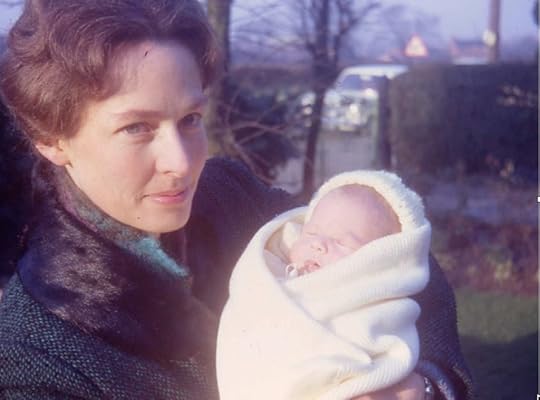 My Mum. And me (aged 2 weeks).
My Mum. And me (aged 2 weeks).
March 1, 2018
Not Doing
Tonight I’m going to the launch of Not Doing: The Art of Turning Struggle into Ease, the latest book by Steven d’Souza, author of Not Knowing. I was a contributor to the book, and this evening I’ll be speaking on a panel alongside Mac Macartney, Gerald West and Mark Walsh, as well as Steven, to expand on this idea of Not Doing.
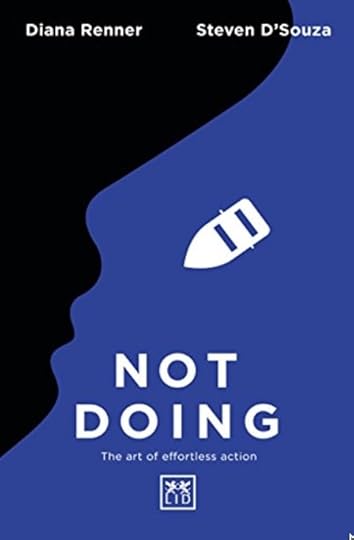 Loving the image of the rowboat on the cover
Loving the image of the rowboat on the coverNot Doing? I hear you ask. But then how would things get, well, done?
And you would be right, somewhat. Without a certain amount of doing, there would be no books, music, art, houses, companies, electronics, medicine, or countless other things that we rely on for our lives, wellbeing and comfort.
It’s more a question of how much doing, and what kind.
Rowing across oceans, you would imagine, involves an awful lot of doing. As well as the 12 hours of rowing a day, there is also the doing of maintenance, cooking, blogging, logbooking, sleeping when possible, and so on.
There is certainly plenty of physical doing, but mentally, it’s a different story. Mentally, there is time and space and opportunity to let the mind wander, to imagine, to remember, to philosophise, to wonder, to let the mind explore its own nooks and crannies. Sometimes, it could fairly be said, there is too much time for this, especially when those nooks and crannies contain demons that you thought you’d left behind long ago. But even when it is challenging and scary to let the mind wander at will, those months alone at sea were times that I cherished. There was time to watch the clouds, admire the beauty of sunrises and sunsets, feel joy at the passing company of a whale or a pod of dolphins. In short, there was time to simply be.
By contrast, I can remember making landfall in Honolulu, Hawaii. Most of my landfalls were on relatively laid-back tropical islands, but Honolulu is intensely commercial. I recall flinching at the sudden transition from the ocean wilderness to a world of cars, crowds, tall buildings, and shops selling electronics, designer clothes, and jewellery. Even though most people were presumably on holiday, they still seemed to be in a frenzy of doing, and a lot of the doing seemed to be based around stuff.
One of the messages I took away from the movie Tawai was that, in a healthy ecosystem, hunting and gathering doesn’t take much time, leaving plenty of opportunity for relaxing and socialising. So why is it, that for most of us in the western world whose needs are more than adequately met, we still feel the need to rush around in pursuit of more?
 Doing has its place, but I’d like to suggest that we have become too much yang, and not enough yin, too much doing, and not enough being.
Doing has its place, but I’d like to suggest that we have become too much yang, and not enough yin, too much doing, and not enough being.
We are a world out of balance. Even mindfulness, which is exploding in popularity, is in danger of becoming one more thing that we have to find time to do. Meditation, as I interpret it, is meant to be more a way of being than a thing of doing.
Where is all this doing getting us?
Stressed, burned out, lost and confused. It takes time – real, proper, deep thinking time – to figure out who we are, what we want, and where we are going. When we deny ourselves that time, we blunder on regardless, but without a clear sense of direction or purpose. It’s only when we see the insanity of the whole doing enterprise that we can step off the hamster wheel and get some clarity.
Yesterday I had a wonderful conversation with Bex Band of Love Her Wild. You’ll see from her bio that Bex opted out of the corporate world, and found a whole new world of possibility based on a simpler lifestyle that prioritised experiences over expenditure. Ditto my friends Nix Moss and Casey Sheppard. Ditto The Monk Who Sold His Ferrari (yes, I know it’s not true). Ditto Happier People, Healthier Planet, and The Moneyless Man. Oh, and ditto me.
It becomes clear that doing less is not just an attractive option, but also an environmental imperative.
I am reminded of the story of the fisherman and the businessman, which I highly recommend you take one minute to read.
Fittingly, today the card I drew from my Zen Osho deck was “Slowing Down”, with an image of a tortoise. The interpretation includes this passage:
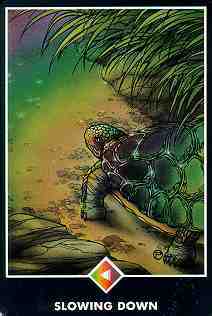 “Walking is Zen, sitting is Zen.
“Walking is Zen, sitting is Zen.
Then what will be the quality? Watchfully, alert, joyously, unmotivated, centred, loving, flowing, one walks. And the walking is sauntering. Loving, alert, watchful, one sits, unmotivated – not sitting for anything in particular, just enjoying how beautiful just sitting doing nothing is, how relaxing, how restful…
After a long walk, you sit under a tree and the breeze comes and cools you. Each moment one has to be at ease with oneself – not trying to improve, not cultivating anything, not practicing anything.
Walking is Zen, sitting is Zen.”
So take a moment today to saunter, to not do, but simply to be.
Other Stuff:
Most of my time at the moment is spent conceptualising The Sisters, a global women’s network I intend to launch later this year.
But also this week various enjoyable meetings – with Casper Craven, whose book about sailing around the world with his wife and three young children comes out this May; with Anuradha Das Mathur from the Vedica Scholars in India; a lunch kindly hosted by Rajni and Sri from the Wings of Hope charity to thank those of us who spoke at their Back to School event in January; champagne at the top of The Gherkin with the Cordon Rouge Club (that was a particularly tough tour of duty, as you can imagine); catching up with the Thought Expansion Network, who manage my speaking engagements; and a delightful and formative conversation with Jay Golden of Retellable.
Tomorrow I’m off back to Mexico for the World Ocean Summit, and to spend more time with the team behind the Noomap/Infinite World Game.
Ah well, look at me and all this doing I’m doing! But I promise you, also taking good time for thinking and being.
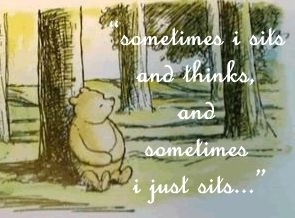
February 22, 2018
The Chalice and the Blade
When three people, quite independently, suggest that I should read the same book, I pay attention. On this occasion, I’d like to thank those who recommended The Chalice and the Blade, first published in 1987, which rings as true now as it did when it first came out. Available in 26 different languages and with over half a million copies sold, it is definitely a book of significance.
 What I loved about it was that it confirmed a hunch that I’ve long had, that gender equality and sustainability are somehow entwined. I had thought that maybe this would be because the stereotypically “feminine” qualities of compassion and nurturing would lead to greater consideration for the non-human and future human inhabitants of Planet Earth.
What I loved about it was that it confirmed a hunch that I’ve long had, that gender equality and sustainability are somehow entwined. I had thought that maybe this would be because the stereotypically “feminine” qualities of compassion and nurturing would lead to greater consideration for the non-human and future human inhabitants of Planet Earth.
But Riane Eisler takes a different view which, on reflection, I think is stronger. She suggests that, under Cultural Transformation Theory, there are two basic models of society:
Dominator model = ranking of one half of humanity over the other, in either patriarchy or matriarchy
Partnership model = social relations based on linking rather than ranking. Groups can be different without being either inferior or superior.
After a rigorous examination of the archaeological evidence, she concludes that the original direction of our cultural evolution was towards partnership, but following a period of chaos and disruption around 5,000 years ago there was a fundamental shift towards domination, and we moved from a life-generating and nurturing view of the Universe (chalice/grail) to worship of the blade (the power to take life).
Although she bases her argument in the relationship between the two halves of humanity, she extrapolates that dominator mentality to domination not only over women, but over weaker men, over other countries, over nature – in fact, over anything that can be classified as “other”. She writes: “…once the function of male violence against women is perceived, it is not hard to see how men who are taught they must dominate the half of humanity that is not as physically strong as they are will also think it their “manly” duty to conquer weaker men and nations.”
(I shall leave it to you to picture the many examples of the dominator mindset current in the world today.)
With intellectual and well-researched rigour, she explodes some powerful myths:
Humans are naturally warlike and violent.
Not so, she says. Too much archaeological evidence has been interpreted through the lens of what the historian expected to see, rather than what was there. “Spears” in cave paintings were more likely branches or reeds. “Weapons” were more likely tools. Until one particular culture started marauding and put everybody else on the defensive around 5,000 years ago, it is likely that most prehistoric peoples lived peacefully and cooperatively.
Males have always dominated females.
 Not so. Again, the evidence has been misinterpreted. Historians assumed that if a society wasn’t patriarchal, it must be matriarchal, so when they didn’t find evidence of matriarchy, they concluded that males must have always been dominant. But looking at the evidence more objectively, it seems to suggest that in prehistory the two genders were regarded as different, but equal.
Not so. Again, the evidence has been misinterpreted. Historians assumed that if a society wasn’t patriarchal, it must be matriarchal, so when they didn’t find evidence of matriarchy, they concluded that males must have always been dominant. But looking at the evidence more objectively, it seems to suggest that in prehistory the two genders were regarded as different, but equal.
Biological evolution necessarily leads to cultural evolution.
There is in many ways an implicit assumption that things get better as time progresses – that as human bodies and brains evolve, so does our wellbeing. If that is so, then if we moved from equality to patriarchy, then patriarchy must be an evolutionary step forwards. QED. But “progress” is not always progress – see last week’s blog post on Surviving Progress. It is entirely possible to take an evolutionary wrong turn – and in the present case, that turn could take us into an irrevocable dead end. Literally.
Equality is about a lot more than women’s rights. It’s about human rights. And if we can’t get human rights sorted out, there isn’t too much hope for nature’s rights.
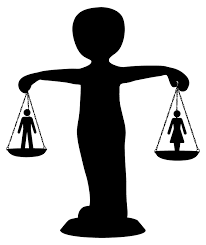 It’s time that we moved out of this ill-fated dominator narrative, and into a healthier relationship dynamic. Fundamentally, we need a different story about what it means to be a human in the 21st century, because the stories we tell become the reality we get. To give Riane Eisler the final word…
It’s time that we moved out of this ill-fated dominator narrative, and into a healthier relationship dynamic. Fundamentally, we need a different story about what it means to be a human in the 21st century, because the stories we tell become the reality we get. To give Riane Eisler the final word…
“An important lesson to be learned from the rise of modern totalitarianism is that it can be a fatal error to underestimate the power of myth. The human psyche seems to have a built-in need for a system of stories and symbols that “reveal” to us the order of the universe and tell us what our place within it is. It is a hunger for meaning and purpose seemingly beyond the power of any rationalistic or logical system to provide.”
Other Stuff:
For more on Riane Eisler, you might enjoy this recent interview by Scott London.
Those long flights have had their revenge. I now have a stinking cold and have had to cancel all my meetings this week. On the plus side, it has given me time to catch up on some reading.
Before the cold got the better of me, I went to see the much-talked-about and much-nominated The Shape of Water. Very strange. I couldn’t make much sense of it until I decided to interpret it through the lens of The Chalice and the Blade, and turn it into a goddess/redemption story. According to my version, Elisa is the goddess, fallen from grace, who has to redeem herself by being incarnated as that poor, downtrodden creature, a woman in 1960s America, and a mute to boot. [Spoiler alert! Don’t read further if you don’t want to know what happens!} She falls in love with the sea creature, who is referred to more than once as “a god”. Her love for him redeems her, and after dying as a mortal she is reborn as her true self, the goddess and his true soulmate. Her gills are proof that this was her destiny.
Well, heck. I don’t know. Feel free to make up your own interpretation!
February 15, 2018
Valentine’s Day: I
Valentine’s Day may seem an odd day to watch two movies about how fast the world we know is disappearing, but it seemed strangely appropriate. It reminded me just how much I love this world, and how important it is it to me – and, I would hope, to all of us – to ensure that we preserve the loveable parts of it for the future, which will require us to leave behind some of the less loveable parts of our human nature.
Surviving Progress, a film by Mathiew Roy and Harold Crooks, featuring such folks as Martin Scorcese, Stephen Hawking, Craig Venter, Vaclav Smil, Jane Goodall, Margaret Atwood, Colin Beavan (aka No Impact Man), and Ronald Wright.
 Jane Goodall
Jane GoodallCombining neuroscience and environmentalism, the film argues that we are running 21st century software (i.e. contemporary levels of technology and knowledge) on hardware that hasn’t been upgraded in 10,000 years (i.e. our brains). Although we can project into the future, most of our brain systems evolved to operate in a much simpler world, where threats were obvious and immediate. So although it’s clear that we have too many people, and not enough planets, our cognitive processes aren’t responding to the existential threat that looms over us, because it’s not the “right” kind of threat to prod our primal instincts into action.
Something from the film that really resonated with me was the idea of a “progress trap” – an innovation that seems to be progress in the short term but proves to be a dead end in the long term. For example, creating a better spear to kill two mammoths rather than one is progress. Learning to kill two hundred mammoths by driving them over a cliff is a progress trap, because although in the short term it gives your tribe more food than they can possibly eat, in the longer term it leads to the extinction of mammoths.
I’m sure you can think of countless other examples where more is not better, but unfortunately our instincts often get the better of our more rational brains. “More equals good” is our ultimate progress trap.
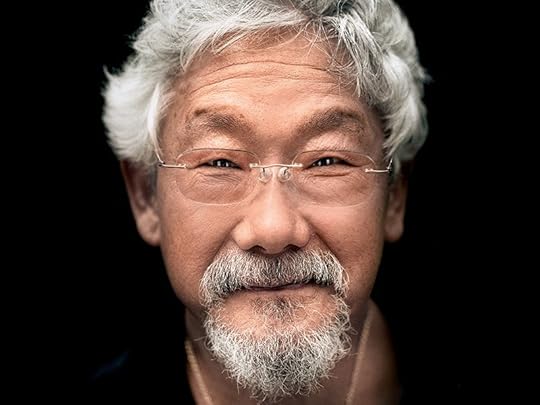 David Suzuki
David SuzukiMemorable quotes:
Ronald Reagan on the floor of the New York Stock Exchange in 1985: “We’re going to turn the bull loose.” (And what a bull in a china shop that turned out to be.)
Margaret Atwood: “Unless we can preserve the environment, there isn’t going to be any more ‘the economy’.”
David Suzuki: “Conventional economics is a form of brain damage.”
Marina Silva: “It is impossible to defend models that cannot be universally applied, because we would have to start from a premise that some people have rights and some don’t. Thus there is no technological problem, but an ethical one.”
The film ends by asking whether civilisation, indeed humanity, may turn out to be a failed evolutionary experiment – or whether we can upgrade our thinking in time.
(Thank you, Michelle Driskill-Smith, for recommending the film!)
Racing Extinction, a great film by Louie Psihoyos, who also brought us the Oscar-winning The Cove. (And also includes Jane Goodall – she has been busy.)
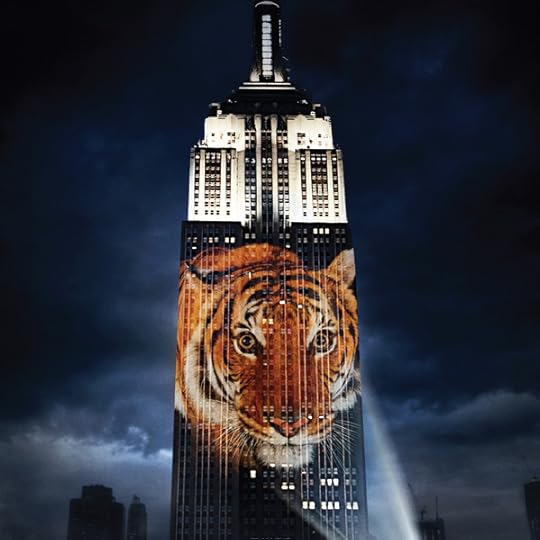 Empire State Building
Empire State BuildingUnashamedly pulling at our heart strings, the film brings us the sound of the last Moho bird of Hawaii singing for a mate that will never come; a finless shark taking its last gasps; manta rays being chopped up on an Indonesian beach (interesting study here on the intelligence of mantas); and the stunning fact that around 200,000 sharks are killed every day for a soup that apparently doesn’t even taste all that good.
After the tear-jerkers comes the optimistic part, with the kind of guerrilla tactics that distinguished The Cove as a kind of exciting thriller against the usually depressing genre of environmental distress porn. Psihoyos and his team enlist Elon Musk and a (presumably donated) Tesla with an onboard mega-projector to beam massive images of rapidly vanishing species onto iconic buildings such as New York’s Empire State Building. Crowds duly gather, rapt in awe as they gaze on the poster children of our fast-disappearing wildlife.
The story ends with the motivating message that “It’s better to light one candle than curse the darkness.”
The film reminded me of two quotes that I think about every single day, and which give a powerful clue as to how we get ourselves out of this evolutionary corner we are rapidly painting ourselves into:
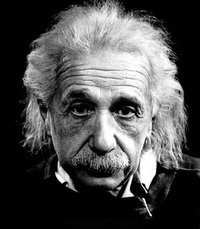 “You never change things by fighting the existing reality. To change something, build a new model that makes the existing model obsolete.” (Buckminster Fuller)
“You never change things by fighting the existing reality. To change something, build a new model that makes the existing model obsolete.” (Buckminster Fuller)
“No problem can be solved from the same level of consciousness that created it.” (Albert Einstein)
So, ergo, we need a new level of consciousness, and a new model of reality. And we all need to play a part in that. I urge you to watch both these films, and not to curse the darkness, but rather to find a candle that you feel inspired to light.
P.S. How heartbreaking is this? Men’s Journal features “25 Place to See Before They Disappear”.
Other Stuff:
Human nature is an odd phrase, when you stop to think about it – and has often been used to excuse our less-than-impressive behaviour. We’ve been told that it’s in our nature to be greedy, selfish, and violent. But according to the book I’m reading, The Chalice and the Blade by Riane Eisler, this is not so. Her interpretation of the archaeological evidence is that until around 5,000 years ago, humans enjoyed what she calls a culture of “relationship”, in which peace and harmony prevailed. But then marauding hordes from a single warlike tribe started fanning out across the world, propagating a culture of “domination”, which came to be the new normal – domination of human over nature, and of male over female. I haven’t finished the book yet, but the author seems to be offering hope that, if we can go from relationship to domination, it may be possible to spiral back again to a world of equality and mutual respect.
 I’m now back at home in Windsor after three weeks away in California and Mexico, a wonderful time in which I made many new friends and saw many new places. One of the highlights was meeting the Noomap team in Tepoztlan, Mexico (apparently the birthplace of the feathered serpent, Quetzalcoatl, pictured left – luckily I didn’t meet him). We were able to spend about 24 hours together, getting to know each other and exploring ideas for the future. More on that in due course.
I’m now back at home in Windsor after three weeks away in California and Mexico, a wonderful time in which I made many new friends and saw many new places. One of the highlights was meeting the Noomap team in Tepoztlan, Mexico (apparently the birthplace of the feathered serpent, Quetzalcoatl, pictured left – luckily I didn’t meet him). We were able to spend about 24 hours together, getting to know each other and exploring ideas for the future. More on that in due course.
I also had a wonderful evening with the Young Presidents Organisation in Mexico City. Around 150 turned up to hear me speak – a wonderful, warm, welcoming audience. Many thanks to my former next door neighbour while at Yale, Gabriela Hernandez, for her part in making that happen, to Arturo and Gabriel for organising, and to everybody who came along.
That’s all for now folks. See you next week!
February 8, 2018
The Power of What If
“What If” is one of my favourite games of the imagination, and gives plenty of food for thought, so I hope you enjoy this as an exercise in enhancing your creative skills – and possibly even changing the way you see the world.
You might be aware that for some time I have been fascinated by the nature of reality. I wrote this blog post on Courage and Truth while I was teaching at Yale last year. And my favourite books of 2017 also threw up several volumes on the subject. The long and short of it is, I’m not at all sure that what our dominant western culture tells us is real is really as real as it pretends to be. (My friend Ellen Leanse writes compellingly on this subject over at Medium.com – check out this one on The Myth We Build Together.)
So if reality isn’t real, then what is?
Well, I’m not going to tell you. Even if I claimed to know (which I don’t, although I feel I’m getting closer), that would defeat the point of the game, which is to pretend to yourself for a few days that things are not as you have been told. So you ask yourself, “What if this belief were not true?” or “What if this were so?”
And decide for yourself if the alternative makes you feel happier, worse, or about the same.
To keep this manageable, I’d recommend you pick one “fact” – or let’s call it a “belief” – at a time. Else you may completely lose your bearings, and/or your head may explode.
Here are some beliefs you might want to play with – or at least these examples will help get the ball rolling as you come up with your own ideas… And please remember, this is just a thought experiment. These questions are intended to get you thinking more flexibly and curiously. It’s meant to be fun, not cause existential angst!
What if every person in your life was conjured up by you to help you learn the things you need to learn?
What if everybody really did/is doing their best (even if it’s not very good)?
What if nobody is judging you half as much as you think they’re judging you?
What if everything really does happen for a reason?
What if you allowed yourself to get bored, rather than checking your phone 100 times a day?
What if you didn’t compare yourself with other people all the time – your salary, your looks, your weight, your clothes – and just concentrated on being you?
What if money actually doesn’t make the world go round?
What if that self-limiting belief isn’t true?
What if you really do create your own reality?
What if everything is exactly as it is supposed to be?
What if you are divinely blessed?
What if you are, in fact, divine?
I hope you enjoy giving this a try. Maybe you’ll find some new beliefs that work a lot better for you than the ones you used to hold. My philosophy is: so long as my belief system doesn’t impinge on anybody else’s liberty to believe what they want, we are free to choose the beliefs that work best for us. I used to play this game on the boat – all alone in the middle of an ocean, I had a lot of freedom to try out “what ifs”, and found that some ways of looking at the world, and my role in it, definitely worked better than others.

Other Stuff:
Having a wonderful time in Mexico City. Last night I spoke at a very enjoyable gathering of the Young Presidents Organisation and their families. Many thanks to Gabriela, Arturo, Gabriel, and all the other people who helped make it happen and made the evening itself so much fun.
Howard and I have also had the chance to explore San Miguel de Allende, the pyramids at Teotihuacan, the Museum of Anthropology, and this weekend I’m off to Tepoztlan.
February 1, 2018
Synchronicities and Serendipities
I’m curious – have you noticed a higher than normal occurrence of synchronicities in your life recently? Since the start of 2018 I’m noticing more than average instances of perfect timing, small world moments, and tremendously convenient coincidences. It’s getting spooky.
 For example… This Friday Howard and I are having dinner with a very successful producer and his wife. You might recall from an earlier blog post that I’ve been using this trip to LA to see if there might be interest in a feature film based on my life story. For the last few months, I’ve been describing the project as “Erin Brockovich meets Life of Pi”. Earlier in January, just as I was finishing lunch with Michael Palin (did I mention I’d had lunch with Michael Palin?!) another friend of his dropped by. That friend had worked with Michael on A Fish Called Wanda, and also happened to be one of the producers on…. Erin Brockovich.
For example… This Friday Howard and I are having dinner with a very successful producer and his wife. You might recall from an earlier blog post that I’ve been using this trip to LA to see if there might be interest in a feature film based on my life story. For the last few months, I’ve been describing the project as “Erin Brockovich meets Life of Pi”. Earlier in January, just as I was finishing lunch with Michael Palin (did I mention I’d had lunch with Michael Palin?!) another friend of his dropped by. That friend had worked with Michael on A Fish Called Wanda, and also happened to be one of the producers on…. Erin Brockovich.
Coincidence? Manifestation? Who knows.
The most recent occurrence happened about an hour ago. This morning I delivered a keynote for Kaiser Permanente here in Huntington Beach, California. All went well, and I was enjoying a relaxing afternoon when I decided to go get a cup of tea from the coffee shop on the far side of the resort. On the way, I bumped into someone I had last seen two years ago at a different conference and had really got along well with. He works for Kaiser Permanente too, but wasn’t meant to be at this conference. How lucky that I chose that particular moment to schlep over to get my afternoon cuppa, that I chose that particular route, and that Wade also happened to be walking that way.
Funnily enough, Wade mentioned that he’s experiencing a lot of perfect timings this year, which got me thinking….
Is this a widespread phenomenon?
Neither of the instances above is remarkable in themselves, but I have experienced at least half a dozen other significant examples since the start of the year. Perhaps I think of a person I haven’t heard from in years, and shortly thereafter get an email from them. A single concept, that I may never have heard of before, crops up three times in as many days. I arrive in LA, and by chance a disproportionate number of my friends happen to be in town. Even though I can find no logical reason (in a linear Newtonian world) why these things happen, it feels as if they are not random (could this be a quantum world?).
 What is going on here?
What is going on here?
You can make up your own mind on the meaning (or lack thereof) of synchronicities, but there are definitely those who believe they are significant.
Around 2002 or 2003, I read a book that changed my worldview: The Celestine Prophecy. The narrator is in a transitional period of his life – as indeed I was at that time – and begins to notice instances of synchronicity, which lead him like a sequence of clues into a spiritual adventure. “Coincidences” become something important to pay attention to.
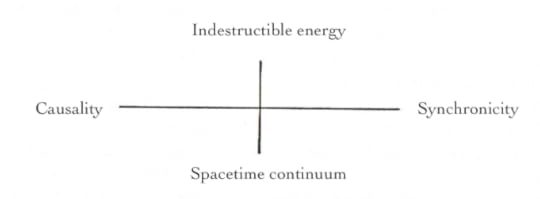 Jung’s view of synchronicity
Jung’s view of synchronicityThe term synchronicity was first coined by Carl Gustav Jung to describe events that have no apparent causal connection, but to the person who experiences them there is a subjective sense that there is a meaningful connection. Lots more on this on Wikipedia’s Synchronicity entry.
I had an aged friend, who sadly passed on a number of years ago. Sir John Rawlins was fascinated by synchronicities, and along with a friend he recorded all such events in a notebook. He believed that an acceleration of synchronistic occurrences would be significant. Too bad he’s not around for me to ask him what he believed the significance to be.
So I will ask you. I have three questions:
Are you experiencing more synchronicities than normal?
Do you attribute any significance to that?
If so, what significance?
Myself, I choose to believe that synchronicities are like a little wink from the Universe. We may often feel we live in a VUCA* world, where all is chaos and randomness, but once in a while the veil is lifted, and we see that there is, if not exactly a plan, then at least some degree of method to the madness. And then we can relax into the flow and know that we don’t travel alone.
*(A military acronym: Volatile, Uncertain, Complex, Ambiguous – also the subject of my keynote this morning, on Navigating the Future)
Other Stuff:
Having a fabulous time in LA – catching up with old friends and forging new connections. Tonight we have a screening of my Atlantic documentary in Marina del Mar. If you’re interested, and/or if you know film industry people, please contact Autumn Udell for further details.
 Tepoztlan
TepoztlanSpent the weekend in San Diego brainstorming a new project I’m working on – a global women’s network. Once #MeToo has finished venting millennia of fury, we need a new vision to come into play: a world in which masculine and feminine are in balance. I am fascinated with creating that vision. More on that soon.
Next week we go to Mexico City and Tepoztlan. Tepoztlan was one of the Universe’s best efforts this year – I’d never heard of it before, and yet it turns out that a team of radically innovative software developers that I want to meet just happen to be there, about an hour and a half outside Mexico City. Happy coincidence indeed.
January 25, 2018
Tawai: A Voice from the Forest (film review)
Tawai is the word the nomadic hunter gatherers of Borneo use to describe their inner feeling of connection to nature, and is also the name of a film that I highly recommend.
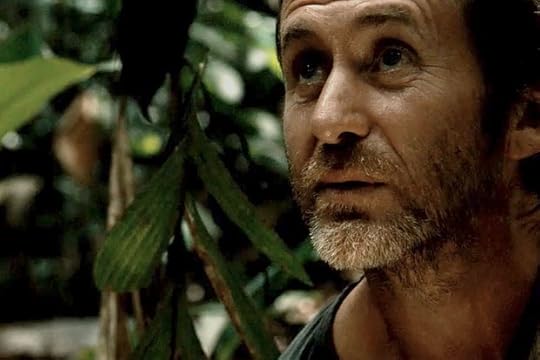 Bruce Parry
Bruce ParryTawai is the first film directed by Bruce Parry, who featured in various series for the BBC. He was best known for Tribe, in which he spent time living with various indigenous communities, getting to know them and taking part in their rituals – often painfully (4-min video here of his eye-watering experiences with the Kombai – I recommend NOT watching it while eating your cornflakes).
I was curious to see the film. I’d met Bruce once, briefly, at Buckingham Palace (as you do) when the Queen had a big party for explorers and adventurers back in 2012 to celebrate the centennial of Captain Scott’s ill-fated Terra Nova expedition to the South Pole. I found him talking to Benedict Allen about his (Bruce’s) decision to abstain from alcohol and sex for 6 months in pursuit of higher levels of consciousness. (I hope I have got those details right. Champagne was involved.)
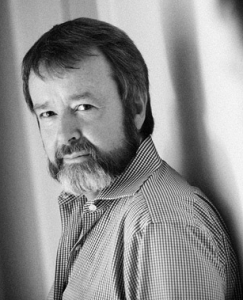 Iain McGilchrist
Iain McGilchristThe film also features Iain McGilchrist, who I know quite well, having shared a stage with him, attended one of his workshops, read his book, The Master and the Emissary (about the two hemispheres of the brain), and stayed at his home on the Isle of Skye, a very magical place that also appears in the film.
In Tawai, Bruce returns to some of the tribespeople of the Amazon and Borneo, interweaving footage of their lives with perspectives from western experts. Do check out the trailer.
A few moments that stood out for me were:
..Hunter-gatherers stalking their prey in the forest, utterly attuned to their surroundings, perceiving every sound, smell, and sight. Then cut to hectic street scene in India, with voiceover to the effect that in an urban environment there is so much sensory input that we simply can’t take it all in, so we have to narrow our focus to what is immediately relevant to us. The danger is that this narrowing of the focus becomes habitual, so we see only what we expect or want to see.
..A tribesman showing Bruce the huge swath that has been cut through the forest to make way for a pipeline. He tells Bruce that the animals have completely left that area, driven away by the noise and disruption.
..Tribespeople turning to agriculture as their traditional hunter-gatherer lifestyle is increasingly affected by incursions on the forest by logging. The sombre mood as they tend their crops felt very different from the simplicity and abundance of their foraging in the forest.
..As the tribespeople abandon their traditional nomadic lifestyle and move into a longhouse, a shot of a man vainly trying to kill all the creepy-crawlies with bug spray. For me this illustrated how we were once used to living at one with nature, but once you put up walls and a roof, nature is something to be kept outside of human habitations, and any nature that strays indoors is to be killed.
..The happiness, playfulness, and intimacy of the interpersonal relationships within the tribe.
..An acknowledgement of the interconnectedness of everything. We were not designed to be separate from nature. We are part of it.
..And a moment of light relief – Bruce Parry sweeping dust from the steps in India with a brisk beating motion of the broom. An Indian swami comes and takes the broom from him and shows him how to gently sweep the dust away. Much more effective.
I don’t want to over-idealise the lives of the hunter-gatherers. I’m sure it has its discomforts and challenges, and clearly a human population of over 7 billion could not be sustained that way (which is a whole other topic of conversation).
 But I left the Merlin Theatre in Frome, Somerset, wondering if we might have lost more than we’ve gained. We might have mobile phones, pharmaceuticals, exotic holidays, fast cars and luxurious homes. But we have also to some extent become isolated, from intimate human connection, from nature, from the very essence of ourselves.
But I left the Merlin Theatre in Frome, Somerset, wondering if we might have lost more than we’ve gained. We might have mobile phones, pharmaceuticals, exotic holidays, fast cars and luxurious homes. But we have also to some extent become isolated, from intimate human connection, from nature, from the very essence of ourselves.
Much damage has been done, but it’s not too late to find our way back to a better balance. I’m certainly not saying we should all go live like hunter-gatherers – but rather that there is something in their culture that is valuable, irreplaceable, and seriously under threat, and that we would be wise to pay attention to. That “something” is the deep knowledge that we’re all connected in this intricate web of life, so the damage we do to the web, we ultimately do to ourselves. And by healing our relationship with that web, we heal ourselves.
[My only criticism of the film would be the lack of female voices. I acknowledge the cultural obstacle to getting the tribeswomen to speak directly to the interviewer, but maybe if Bruce had taken a female colleague with him, we could have heard more from the female perspective. And/or more female experts.]
Other Stuff:
Last Sunday I spoke at Back to School Day at Dulwich College for Wings of Hope. A pleasure to meet Justin Webb of BBC Radio 4’s Today programme, and to catch up with Lord Butler. Also a privilege to share a room with the James Caird, the boat used by Ernest Shackleton and 5 of his men to row from Elephant to South Georgia in the South Atlantic after their Antarctic expedition went pear-shaped. The JC is exactly the same size as my rowboat (23 feet by 6) – but very glad I spent most of my time in warmer waters!
My partner’s 15-year-old daughter, Bella Lack, has just been chosen to take over Rob Edwards’ animal conservation Twitter account, Lionheart0075, based on her passion for wildlife. Please follow!
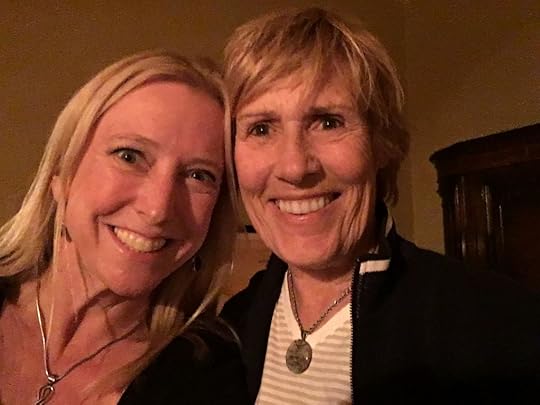 With Diana Nyad
With Diana NyadGreetings from sunny LA! I arrived on Monday for a speaking engagement next week. For now I’m meeting with friends both existing and new, including Meredith Blake of ProSocial, who orchestrated the social impact campaign around An Inconvenient Truth, and Diana Nyad, the legendary swimmer who swam 110 miles from Cuba to Florida, without a shark cage, at the age of 64. And Jim Salzman, Professor of Environmental Law at UCSB.
My dear friend Casey Sheppard is in the final stages of preparing to cycle the length of New Zealand, to inspire girls to adventure. Please check out her fundraising page and support! (and take a look the stop-motion video – thanks for the shout-out, Casey!)



